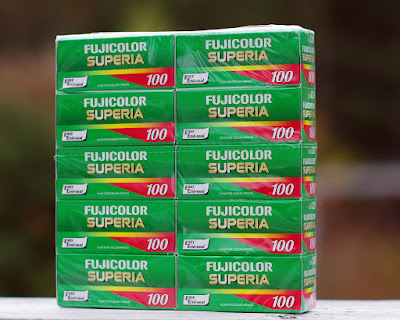Older stocks from the late 1990's, despite being frozen, are nevertheless decayed passed there usefulness. The latest incarnation of capable films from the 2000's will keep awhile yet. Film degrades with time, with slower films doing well even after 10 years in the freezer. For best storage life film must be purchased and frozen before it expires, and it must be consistently held in "suspended animation". Therein lies the rub, finding this properly kept stock in late 2015.
 |
| A treasure trove! To my good fortune, a fresh frozen brick of Fujicolor Superia 100 |
The last great color film for astrophotography is Superia 100. Not to be confused with Superia Reala 100, a great film for daylight use, Superia CN 100 defies it's specifications. It is red sensitive, but spectral response drops off near 650nm, just shy of Hydrogen-Alpha emission line. The manufacturers recommendation for exposures past 60 seconds is a full stop increase in exposure, not what you would expect in a good astro-film.
 |
| The beautiful region of Cygnus and Cepheus captured on Fujicolor Superia |
Despite its apparent disagreement with its published specifications, the film performs rather well. A 30 minute exposure at f/2.8 creates a dense negative capable of tremendous depth and fidelity. For the best red sensitivity, Kodak's E200 has yet to be beat, however Superia's low halation allows pinpoint stars offering a more refined image.
 |
| The area of Scutum revealed by Fujicolor Superia 100 |
It's time to get busy with the new stock. I have yet to use Superia 100 on the winter sky. I'm anticipating great results on a variety of regions of the Milky Way.
 |
| The Messier 8 Region in Sagittarius on Fujicolor Superia 100 |
I believe my pursuit for film stocks is over. Within 5 to 10 years I will complete my portfolio of astronomical images and start working on other projects. Having photographic film originals versus digital files is a workflow choice. It is not for everyone. May you find your methods just as rewarding.





